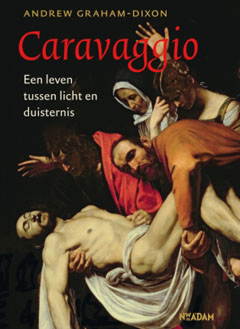Presentator
Wim Brands shows a fragment from Mean Streets by Martin Scorsese, to let
us know how the moviemaker was influenced by Caravaggio. The close-ups of the actors in dark and light are directly copied from the painter. The painting The conversion
of Paul who is filled with light and is a good example of this. The subtitle of the Dutch translation of the Caravaggio biography by Andrew Graham - Dixon is: Een leven tussen licht en duisternis.
BBC-presentator
and art historian Graham - Dixon says he had an interview with Scorsese six years ago
in London. Caravaggio (1571-1610) catches the eye immediately by the roughness
and rawness of his paintings. He was the first painter who used light and dark
in the center of his work and can be called the father of the cinematography.
Andrew Graham - Dixon made
a documentary thirteen years ago, titled How killed Caravaggio?
From then
more and more came up about Caravaggio. Caravaggio was a difficult character. Graham - Dixon had an interview with Keith Richard who saw the picture of Caravaggio on
the back of the book and said that he could have been a Rolling Stone.
Caravaggio
was a pimp, a murderer and sexually very active. He was a dangerous man, but
not a rebel, Graham - Dixon says. When he was a young boy all his male family members
were killed by the plague. That’s why he looked for God during his life. He
wanted to have a fatherfigure. Torn as he was he repeated the same patterns
over and over again. He said that all his sin were mortal. He is a real human
being. By sfregio a cut in the face he died.
The
biography took him hundreds years of research, Graham - Dixon says. Lots of researchers
did parts of it and he did the synthesis. Tracking down all the information was
a lot of work. He also wrote about Michelangelo during that period. Later on
more details about the life of Caravagggio became available.
What would
you ask him if he was still alive? Brands asks.
‘Can I buy
you a drink?’ Graham - Dixon says as a joke, but then more seriously: ‘Did you ever
love somebody? Did you believe in God? Why did you feel so compelled to destroy
your life?
Did he
believe in God? Brands asks.
He wanted
it badly. A priest said that Caravaggio painted the doubt and the fear in the
darkness. Caravagio left room for those who struggled with believing.
Caravaggio
was a painter who leaps across the ages, Graham - Dixon says. The only good artist is
he who represents reality well, Caravaggio said. He knew how good a painter he
was, Graham - Dixon says. He invented Rembrandt, who also learned to break the rules. Caravaggio
brought humanity into the arts. He worked very quickly, maybe in two days he
finished a painting.
Oek de Jong
also likes his paintings very much, as I read in De
wonderen van de heilbot. He will not be the only one.
A link to
the site
of VPRO boeken with more information about Caravaggio.

even juffen (sorry, tis geneties): een presentator heet in 't Engels een (talk)show host.
BeantwoordenVerwijderenthanks, een mens is nooit te oud om nog wat bij te leren.
BeantwoordenVerwijderen